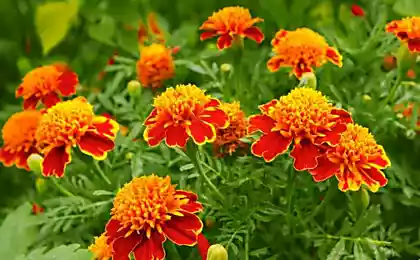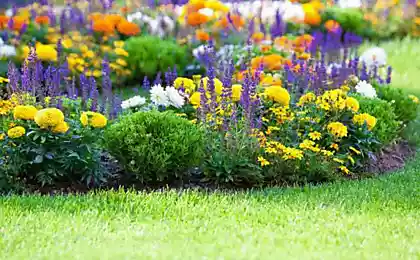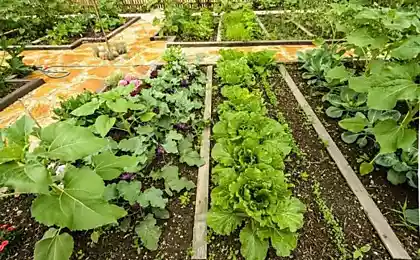756
Marigolds in your garden: growing and care
Eighty four million twenty seven thousand five hundred seventy two
Marigolds, Chornobryvtsi, Tagetes is the most famous name of this flower, brought to us from overseas in the sixteenth century and became perhaps the most beloved and unpretentious denizen of the garden. Its native to Central and South America. Today, according to various estimates, there are between 30 to 50 species of marigolds. They belong to the family Compositae, or Asteraceae. In addition to decorative bright colors (simple and double), and pinnately dissected leaves, chornobrivci have a specific smell, evidence of the high content of volatile production – substances that have a beneficial effect on the human body and is able to scare off pests like the flower and surrounding plants. Tagetes is widely used as a spice in Caucasian cuisine, where it is referred to as Imeretian saffron, and also has a number of medicinal properties.
But how to grow this unique flower? So marigolds: growing from seed.
Eight million two hundred twenty nine thousand six hundred forty eight
Sowing seedlings of marigolds are determined on the basis of two main factors:
climatic conditions of the region, namely the time when the set temperature is favorable for growing these heat-loving flowers, and there is no threat of the return of frost;
desired time of beginning of flowering, it should be noted that from planting to appearance of first flowers, depending on the characteristics of varieties and cultivation conditions, is of 1.5-2.5 months.
Period of when to plant marigold seedlings is best, is the second half of March – first decade of April. In the presence of additional radiation and favorable temperatures, you can plant marigold seeds in January and February, but then flowering will begin in April-may, when planting seedlings in open ground yet. This option is more suitable for those who are going to grow flowers in the container on the glazed balcony or loggia.
As Tagetes does not require specific conditions for growing seedlings, it is successfully sown in the open ground. Often this is done in may, when the ground is warm enough and set the stable temperature of air at night does not drop below 5 degrees. In the southern regions of possible planting marigolds in the ground and at an earlier date.
In addition, planning when to plant marigold seedlings, you should also take into account the characteristics of the species. So to get a chorus of blooms in June, erect marigolds sown in the middle of March, and small-leaved and small – a little later, in early April.
Sixty two million seven hundred sixteen thousand five hundred five
The choice and preparation of seed
Often the seeds of marigolds acquire only once, choosing the most pleasurable variety. In subsequent years, growers would prefer to collect seeds from plants.
If you are interested in how to collect the seeds of marigolds, I must say that it's easy. They ripen about 40 days. To collect seeds, quite a few buds to dry just on the Bush. Importantly, during this period there was no rain, that the seeds did not give excessive influence of moisture and do not rot. After drying, the flower ripe seeds are easily removed from the Cup. They need some more to dry in a dark and warm place and then store in paper bags until spring.
As the choice of seeds in the store, and use personally collected it is important to remember that a high degree of germination fresh seeds have a time limitation not exceeding 2 years. Although there is a perception that you can use and seed under 4 years of age. Today most of the varieties grown in culture are hybrids, because the use of seeds collected personally, it is likely that each subsequent generation will preserve the properties of the parent, to a lesser extent.
For a mass germination of marigold seeds sometimes germinated before sowing. In this case, they are placed on a wet natural fabric spread out on a saucer. The saucer is placed in a package and sent in a dark and warm place. After three days the seeds will hatch and you can choose for planting the most successful.
Fifty seven million nine hundred eighty one thousand six hundred seventy three
The characteristics of the soil for growing marigolds Despite the fact that marigolds are considered undemanding plant to get strong seedlings, it is important to choose for planting the optimal composition of the soil. The soil must be fertile and loose, consisting of equal parts peat, humus or compost, loam, and half part sand. Also suitable for planting a regular garden earth, mixed with sand and peat, or prepared potting mix for indoor and garden plants with a neutral level of acidity. On the bottom of the tank should definitely put a 3-inch drainage layer of expanded clay, sand or gravel. To prevent the "black legs" when growing marigolds from seed the soil pre-spill with a solution of fungicide or steamed.
When sowing chernobrivtsev right in the flower bed is to choose places with fertile, neutral or slightly acid loamy soil.
Technology planting marigolds
When to plant marigold seedlings it is the right time remains to fill the prepared soil, plastic containers, magazines or cups and proceed directly to landing. So, how to plant marigolds seeds.
The soil should be lightly compacted and moistened. At a distance of 1.5-2 cm from each other are grooves with a depth of 1-2 cm they evenly at a distance about 1.5 cm from each other, spread the seeds. Grooves sprinkled centimeter layer of soil, consisting of equal parts of garden soil and sand. It is important that the seeds are sufficiently recessed so that they are not washed out when watering. In addition, when shallow planting shoots worse than dropping seed peel, which remains on the cotyledon leaves and prevents the active development of the plant. At the same time, if excessive sinking seeds germinate longer or might not come up.
Plantings of marigold seedlings carefully watered and germinated in a light place at a temperature of 22-25 degrees. Additional cover to maintain humidity in a container is not required, although sometimes it is used to shorten the period of germination. After 3-7 days appear shoots. Next, the seedling is kept at a temperature of 15-18 degrees.
When planting marigolds in the open ground seeds are sown in furrows with a depth of about 5 cm, which are pre-watered. Crops cover the soil, shoots appear after two weeks. If seedlings are too thick, they will need to seat. The distance between rows and individual plants is determined based on the characteristics of plant species.
Ninety million one hundred forty seven thousand three hundred five
Care of seedlings of marigolds
When the seedlings germinate, the question arises on how to grow seedlings of marigolds. The main aspect of care – timely watering, which is produced as the drying of the soil. It is important to ensure that the water in the tank and the sump does not stagnate because it can lead to the emergence of "black legs". At the slightest appearance of the disease is necessary to remove the damaged shoots and handle the seedlings with a fungicide.
Despite the insensibility of marigolds, at seedling stage will not hurt them an extra feeding of fertilizer for seedlings every two weeks. In addition, it should be remembered that to fertilize only two weeks after planting, picking or planting, when the supply of nutrients in the soil are exhausted.
Planning when to plant marigold seedlings should not forget about swordplay. It is produced when the seedlings appear 2-3 of these carved leaf. Individual plants are transplanted in cups, cassettes, or seated in the trays according to the scheme of 7×7. Bury the seedlings up to the cotyledons is possible, but that the latter did not contact the soil. This contributes to the formation of a strong root system as extensive stalk develop additional roots. Pick activates the growth of seedlings, due to the increase in volume of soil occupied by individual plants, and after 2-3 weeks she has a well-developed fibrous root system and are ready for planting in a permanent place. Marigolds are resistant to transplant, even in the flowering period. The most robust seedlings obtained by growing seedlings in greenhouses and teplichku.
Marigolds, grown from seed which is a simple procedure even for beginners, and would be a great decoration of the garden. Their flowers only will the whole summer be pleasing to the eye with bright colors, but will be a great addition for the home kit.
Marigolds – bright Sunny flowers in profusion adorn many gardens and orchards. Unpretentious and varied, with a whole Arsenal of useful and even healing properties, they are traditionally perhaps the most popular garden flowers throughout our country. And at the same time, many gardeners-beginners question: how to grow marigolds to get lush bushes with lots of elegant flowers.
Planting marigolds in the open ground
1. The timing of planting.
As you know, marigolds can be grown seedlings and from seed in the open ground. The timing of planting marigolds in a permanent place in both cases approximately the same. When it is better to plant marigolds?
Transplanting of chernobrivtsev as sowing their seeds in open ground is made in late may – early June when a stable temperature and there is no night frost. In the southern regions, as well as having the possibility of creating a protective shelter from the film or agrovolan to plant marigolds can be in April.
2. Site selection and soil preparation.
Before you plant marigolds, it is important to choose for them a suitable place and prepare it for planting. It is worth noting that despite their simplicity, they grow best in loamy soils with a neutral pH level. The main requirement is that the soil was loose and breathable. The most abundant flowering get in areas with good lighting, although the shadow-the penumbra chernobrivtsi also feel bad only bloom less.
For a week or two before the time when the time comes to plant marigolds in a permanent place in the garden, they should be gradually accustomed to fresh air, every day increasing the period of stay of containers with seedlings on the street or an open balcony.
The site for planting is to dig over on a bayonet of a shovel. For the best development of marigold can enrich the soil with mineral fertilizers (NPK, for example) and distributing them in the flower bed at the rate of 30 g per 1 sq. m. and close up in the ground by re-digging. But organic and nitrogen fertilizers is not desirable, since they stimulate the growth of green weight loss flowering.
3. How to plant marigolds.
Marigolds, perennial planting and care, despite the peculiarities of individual varieties, not different difficulties, put in prepared holes. The scheme of planting depends on the variety of features and is usually indicated on the package of seeds. For dwarf marigolds optimal is the scheme 20×20 cm, average height (e.g. some varieties of fine-leaved marigold) — 30×30 cm, high 40×40 cm Depth of planting marigolds in the soil at 1-2 cm more than they were buried prior to replanting. The space around the roots carefully fill with soil. The soil is slightly compacted and watered. It is worth mentioning that watering the top leaves and rain marigolds are not afraid.
Features care chernobrivtsy
Understanding how to plant marigolds, do not forget about the further care of them throughout the season. Although marigolds and do not require special growing conditions, but the basic care for them ought to be rewarded in the form of a bright and large flowers.
The main components of care are considered chernobrivtsy watering, loosening the soil and removing weeds, fertilizing and pest control.
During the growth of marigolds require regular watering. But with the beginning of flowering the number of irrigations reduced to two per week in order to avoid water stagnation and rot. In hot dry weather, evening watering will significantly extend the process of flowering and vegetation marigolds. Even when the flowers are considered to be drought resistant under the influence of high temperatures and lack of moisture they are more susceptible to spider mites, and is simply faster wither and wilt. In the case of chernobrivtsev growing in containers watering in hot weather twice a day.
The question "how to grow marigolds and whether they need regular feeding?"worried about the novice growers. In fact, Tagetes are developing well and bloom, even without additional stimulation with the help of fertilizer, especially if you fill the soil with mineral substances even before landing. But the shortage of nutrients in poor soils reduces duration of flowering and size of inflorescences.
Feeding garlic is usually done 2-3 times during the season: when plants reach a height of 10 cm during the emergence of the first buds and early flowering. To feed use of potash and phosphate fertilizers. It is important to avoid excess nitrogen in the soil, as it will lead to the active development of leaves and stems, but will reduce flowering. Marigolds, the cultivation which is carried out in conditions of limited soil, it is necessary to fertilize every 10-14 days.
In addition to watering and fertilizing, flowers marigolds after planting require regular loosening the soil and removing weeds, as for the full development of the plant needed oxygen to the roots. You can also remove the faded blossoms. This will encourage the plant to further bloom.
Growing marigolds and, in particular, caring for them is usually not be difficult, because the plant does not suffer from pests and diseases. The reason for this is volatile, contained in plants and occurs due to its specific smell. This smell, as well as substances secreted from the roots, often repel pests, not only from the marigolds, but also protect neighboring plants.
However, under adverse conditions chernobrivtsi may be damaged by gray rot, blackleg and bacterial diseases. Often comorbid disease factors are excessive zahumensky and high soil moisture. If you encounter rot affected plant parts, and the whole hive is removed.
Most common pests for they are considered snails and slugs, which live in moist places, and spider mites. The slugs suggest to fight with the bleach, put the jar with her among the bushes. The best prevention of spider mites is considered to maintain an optimal level of humidity, but if you have a problem, then eliminate it with the help of infusion of yarrow, onions and red peppers. Growing marigolds, it is worth remembering that they don't like the processing chemicals.
After flowering, when seeds have been collected, and the bushes dry out, plants removed from the site. Often they are sent to a compost pit, so there not divorced pests.
Important in the cultivation of marigold to take into account the features of specific varieties. So, for example, marigolds Antigua is grown on soil nutrients for the formation of borders and containers, but they are not suitable for the design of reservoirs. At the same time, the variety of the marigold Taishan less whimsical, it is used to fill in the gaps between other plants.
So, the perennial marigolds: planting and care — a concern of many gardeners who are fans of these solar flowers. Today, the most popular decorative varieties of marigolds grown from seed in annual crops, but there are also perennial types of plants used in medicine and cooking. Marigolds in the garden is not only the decoration and protection of less resistant plants against fungi and pests, but a real find from the point of view of traditional medicine, because they have a wide range of medicinal properties. It is because many tend nasobirat and to dry bright buds, and after flowering collect seeds of marigolds to next year again to fill their garden and orchard.published
Source: sadovod-i-ogorodnik.ru
Marigolds, Chornobryvtsi, Tagetes is the most famous name of this flower, brought to us from overseas in the sixteenth century and became perhaps the most beloved and unpretentious denizen of the garden. Its native to Central and South America. Today, according to various estimates, there are between 30 to 50 species of marigolds. They belong to the family Compositae, or Asteraceae. In addition to decorative bright colors (simple and double), and pinnately dissected leaves, chornobrivci have a specific smell, evidence of the high content of volatile production – substances that have a beneficial effect on the human body and is able to scare off pests like the flower and surrounding plants. Tagetes is widely used as a spice in Caucasian cuisine, where it is referred to as Imeretian saffron, and also has a number of medicinal properties.
But how to grow this unique flower? So marigolds: growing from seed.
Eight million two hundred twenty nine thousand six hundred forty eight
Sowing seedlings of marigolds are determined on the basis of two main factors:
climatic conditions of the region, namely the time when the set temperature is favorable for growing these heat-loving flowers, and there is no threat of the return of frost;
desired time of beginning of flowering, it should be noted that from planting to appearance of first flowers, depending on the characteristics of varieties and cultivation conditions, is of 1.5-2.5 months.
Period of when to plant marigold seedlings is best, is the second half of March – first decade of April. In the presence of additional radiation and favorable temperatures, you can plant marigold seeds in January and February, but then flowering will begin in April-may, when planting seedlings in open ground yet. This option is more suitable for those who are going to grow flowers in the container on the glazed balcony or loggia.
As Tagetes does not require specific conditions for growing seedlings, it is successfully sown in the open ground. Often this is done in may, when the ground is warm enough and set the stable temperature of air at night does not drop below 5 degrees. In the southern regions of possible planting marigolds in the ground and at an earlier date.
In addition, planning when to plant marigold seedlings, you should also take into account the characteristics of the species. So to get a chorus of blooms in June, erect marigolds sown in the middle of March, and small-leaved and small – a little later, in early April.
Sixty two million seven hundred sixteen thousand five hundred five
The choice and preparation of seed
Often the seeds of marigolds acquire only once, choosing the most pleasurable variety. In subsequent years, growers would prefer to collect seeds from plants.
If you are interested in how to collect the seeds of marigolds, I must say that it's easy. They ripen about 40 days. To collect seeds, quite a few buds to dry just on the Bush. Importantly, during this period there was no rain, that the seeds did not give excessive influence of moisture and do not rot. After drying, the flower ripe seeds are easily removed from the Cup. They need some more to dry in a dark and warm place and then store in paper bags until spring.
As the choice of seeds in the store, and use personally collected it is important to remember that a high degree of germination fresh seeds have a time limitation not exceeding 2 years. Although there is a perception that you can use and seed under 4 years of age. Today most of the varieties grown in culture are hybrids, because the use of seeds collected personally, it is likely that each subsequent generation will preserve the properties of the parent, to a lesser extent.
For a mass germination of marigold seeds sometimes germinated before sowing. In this case, they are placed on a wet natural fabric spread out on a saucer. The saucer is placed in a package and sent in a dark and warm place. After three days the seeds will hatch and you can choose for planting the most successful.
Fifty seven million nine hundred eighty one thousand six hundred seventy three
The characteristics of the soil for growing marigolds Despite the fact that marigolds are considered undemanding plant to get strong seedlings, it is important to choose for planting the optimal composition of the soil. The soil must be fertile and loose, consisting of equal parts peat, humus or compost, loam, and half part sand. Also suitable for planting a regular garden earth, mixed with sand and peat, or prepared potting mix for indoor and garden plants with a neutral level of acidity. On the bottom of the tank should definitely put a 3-inch drainage layer of expanded clay, sand or gravel. To prevent the "black legs" when growing marigolds from seed the soil pre-spill with a solution of fungicide or steamed.
When sowing chernobrivtsev right in the flower bed is to choose places with fertile, neutral or slightly acid loamy soil.
Technology planting marigolds
When to plant marigold seedlings it is the right time remains to fill the prepared soil, plastic containers, magazines or cups and proceed directly to landing. So, how to plant marigolds seeds.
The soil should be lightly compacted and moistened. At a distance of 1.5-2 cm from each other are grooves with a depth of 1-2 cm they evenly at a distance about 1.5 cm from each other, spread the seeds. Grooves sprinkled centimeter layer of soil, consisting of equal parts of garden soil and sand. It is important that the seeds are sufficiently recessed so that they are not washed out when watering. In addition, when shallow planting shoots worse than dropping seed peel, which remains on the cotyledon leaves and prevents the active development of the plant. At the same time, if excessive sinking seeds germinate longer or might not come up.
Plantings of marigold seedlings carefully watered and germinated in a light place at a temperature of 22-25 degrees. Additional cover to maintain humidity in a container is not required, although sometimes it is used to shorten the period of germination. After 3-7 days appear shoots. Next, the seedling is kept at a temperature of 15-18 degrees.
When planting marigolds in the open ground seeds are sown in furrows with a depth of about 5 cm, which are pre-watered. Crops cover the soil, shoots appear after two weeks. If seedlings are too thick, they will need to seat. The distance between rows and individual plants is determined based on the characteristics of plant species.
Ninety million one hundred forty seven thousand three hundred five
Care of seedlings of marigolds
When the seedlings germinate, the question arises on how to grow seedlings of marigolds. The main aspect of care – timely watering, which is produced as the drying of the soil. It is important to ensure that the water in the tank and the sump does not stagnate because it can lead to the emergence of "black legs". At the slightest appearance of the disease is necessary to remove the damaged shoots and handle the seedlings with a fungicide.
Despite the insensibility of marigolds, at seedling stage will not hurt them an extra feeding of fertilizer for seedlings every two weeks. In addition, it should be remembered that to fertilize only two weeks after planting, picking or planting, when the supply of nutrients in the soil are exhausted.
Planning when to plant marigold seedlings should not forget about swordplay. It is produced when the seedlings appear 2-3 of these carved leaf. Individual plants are transplanted in cups, cassettes, or seated in the trays according to the scheme of 7×7. Bury the seedlings up to the cotyledons is possible, but that the latter did not contact the soil. This contributes to the formation of a strong root system as extensive stalk develop additional roots. Pick activates the growth of seedlings, due to the increase in volume of soil occupied by individual plants, and after 2-3 weeks she has a well-developed fibrous root system and are ready for planting in a permanent place. Marigolds are resistant to transplant, even in the flowering period. The most robust seedlings obtained by growing seedlings in greenhouses and teplichku.
Marigolds, grown from seed which is a simple procedure even for beginners, and would be a great decoration of the garden. Their flowers only will the whole summer be pleasing to the eye with bright colors, but will be a great addition for the home kit.
Marigolds – bright Sunny flowers in profusion adorn many gardens and orchards. Unpretentious and varied, with a whole Arsenal of useful and even healing properties, they are traditionally perhaps the most popular garden flowers throughout our country. And at the same time, many gardeners-beginners question: how to grow marigolds to get lush bushes with lots of elegant flowers.
Planting marigolds in the open ground
1. The timing of planting.
As you know, marigolds can be grown seedlings and from seed in the open ground. The timing of planting marigolds in a permanent place in both cases approximately the same. When it is better to plant marigolds?
Transplanting of chernobrivtsev as sowing their seeds in open ground is made in late may – early June when a stable temperature and there is no night frost. In the southern regions, as well as having the possibility of creating a protective shelter from the film or agrovolan to plant marigolds can be in April.
2. Site selection and soil preparation.
Before you plant marigolds, it is important to choose for them a suitable place and prepare it for planting. It is worth noting that despite their simplicity, they grow best in loamy soils with a neutral pH level. The main requirement is that the soil was loose and breathable. The most abundant flowering get in areas with good lighting, although the shadow-the penumbra chernobrivtsi also feel bad only bloom less.
For a week or two before the time when the time comes to plant marigolds in a permanent place in the garden, they should be gradually accustomed to fresh air, every day increasing the period of stay of containers with seedlings on the street or an open balcony.
The site for planting is to dig over on a bayonet of a shovel. For the best development of marigold can enrich the soil with mineral fertilizers (NPK, for example) and distributing them in the flower bed at the rate of 30 g per 1 sq. m. and close up in the ground by re-digging. But organic and nitrogen fertilizers is not desirable, since they stimulate the growth of green weight loss flowering.
3. How to plant marigolds.
Marigolds, perennial planting and care, despite the peculiarities of individual varieties, not different difficulties, put in prepared holes. The scheme of planting depends on the variety of features and is usually indicated on the package of seeds. For dwarf marigolds optimal is the scheme 20×20 cm, average height (e.g. some varieties of fine-leaved marigold) — 30×30 cm, high 40×40 cm Depth of planting marigolds in the soil at 1-2 cm more than they were buried prior to replanting. The space around the roots carefully fill with soil. The soil is slightly compacted and watered. It is worth mentioning that watering the top leaves and rain marigolds are not afraid.
Features care chernobrivtsy
Understanding how to plant marigolds, do not forget about the further care of them throughout the season. Although marigolds and do not require special growing conditions, but the basic care for them ought to be rewarded in the form of a bright and large flowers.
The main components of care are considered chernobrivtsy watering, loosening the soil and removing weeds, fertilizing and pest control.
During the growth of marigolds require regular watering. But with the beginning of flowering the number of irrigations reduced to two per week in order to avoid water stagnation and rot. In hot dry weather, evening watering will significantly extend the process of flowering and vegetation marigolds. Even when the flowers are considered to be drought resistant under the influence of high temperatures and lack of moisture they are more susceptible to spider mites, and is simply faster wither and wilt. In the case of chernobrivtsev growing in containers watering in hot weather twice a day.
The question "how to grow marigolds and whether they need regular feeding?"worried about the novice growers. In fact, Tagetes are developing well and bloom, even without additional stimulation with the help of fertilizer, especially if you fill the soil with mineral substances even before landing. But the shortage of nutrients in poor soils reduces duration of flowering and size of inflorescences.
Feeding garlic is usually done 2-3 times during the season: when plants reach a height of 10 cm during the emergence of the first buds and early flowering. To feed use of potash and phosphate fertilizers. It is important to avoid excess nitrogen in the soil, as it will lead to the active development of leaves and stems, but will reduce flowering. Marigolds, the cultivation which is carried out in conditions of limited soil, it is necessary to fertilize every 10-14 days.
In addition to watering and fertilizing, flowers marigolds after planting require regular loosening the soil and removing weeds, as for the full development of the plant needed oxygen to the roots. You can also remove the faded blossoms. This will encourage the plant to further bloom.
Growing marigolds and, in particular, caring for them is usually not be difficult, because the plant does not suffer from pests and diseases. The reason for this is volatile, contained in plants and occurs due to its specific smell. This smell, as well as substances secreted from the roots, often repel pests, not only from the marigolds, but also protect neighboring plants.
However, under adverse conditions chernobrivtsi may be damaged by gray rot, blackleg and bacterial diseases. Often comorbid disease factors are excessive zahumensky and high soil moisture. If you encounter rot affected plant parts, and the whole hive is removed.
Most common pests for they are considered snails and slugs, which live in moist places, and spider mites. The slugs suggest to fight with the bleach, put the jar with her among the bushes. The best prevention of spider mites is considered to maintain an optimal level of humidity, but if you have a problem, then eliminate it with the help of infusion of yarrow, onions and red peppers. Growing marigolds, it is worth remembering that they don't like the processing chemicals.
After flowering, when seeds have been collected, and the bushes dry out, plants removed from the site. Often they are sent to a compost pit, so there not divorced pests.
Important in the cultivation of marigold to take into account the features of specific varieties. So, for example, marigolds Antigua is grown on soil nutrients for the formation of borders and containers, but they are not suitable for the design of reservoirs. At the same time, the variety of the marigold Taishan less whimsical, it is used to fill in the gaps between other plants.
So, the perennial marigolds: planting and care — a concern of many gardeners who are fans of these solar flowers. Today, the most popular decorative varieties of marigolds grown from seed in annual crops, but there are also perennial types of plants used in medicine and cooking. Marigolds in the garden is not only the decoration and protection of less resistant plants against fungi and pests, but a real find from the point of view of traditional medicine, because they have a wide range of medicinal properties. It is because many tend nasobirat and to dry bright buds, and after flowering collect seeds of marigolds to next year again to fill their garden and orchard.published
Source: sadovod-i-ogorodnik.ru
The scale of knowledge of logical errors: find yourself
The most beautiful varieties of roses for Your estate





















